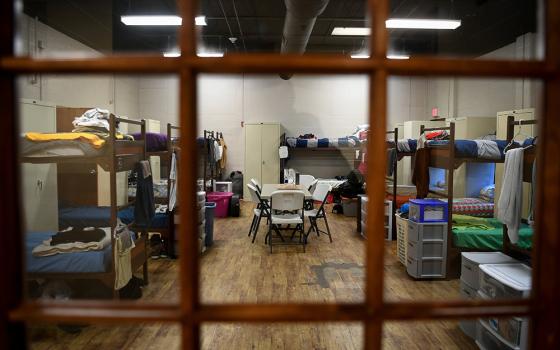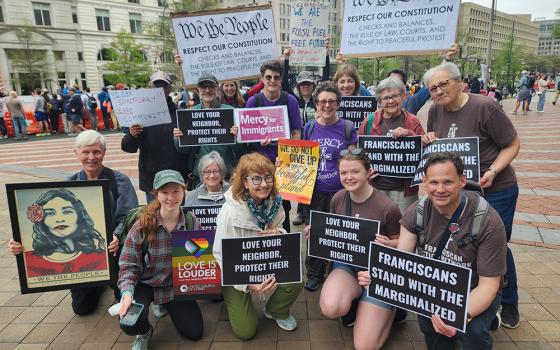America’s bishops have plenty to worry about but not, as some of them claim, that gay marriage threatens to “undermine the institution of marriage.” That, as Jimmy Breslin once wrote, is like “blaming the Johnstown (Pa.) flood on a leaky toilet in Altoona.”
First of all, gay marriages, according to Fox News — hardly a strike force against tradition — barely constitute a percentage and a half of American weddings. Television cameras turn toward them as naturally as spring flowers to the sun but they are a barely orbiting speck rather than an incendiary center of our universe.
Do gay couples look as if they are sword bearing barbarians at the gate or do they resemble ordinary people, us, for example, who would disappear in any crowd, just two people looking apprehensively happy — the look beneath the fixed smiles in many a wedding photo — who seem relieved of stress, as people do when they finally deplane after a long bumpy flight to a destination they feared they would never reach.
The bishops might better focus on the growing social reality of couples who spurn the institution of marriage altogether. They live together and have children and their number, according to Charles Murray (Coming Apart: The State of White America, 1960-2010, Crown, 2012), has dramatically increased at the lower socio-economic level.
The latter group, residents of what Murray terms Fishtown, and a higher socio-economic group, living in what the author calls Belmont, were in 1960 roughly equal in the high percentages of married inhabitants (94 percent in Belmont and 84 percent in Fishtown). The nosedive in marriage that started around 1970 depressed the number of those who took vows in both communities. By 1980, however, the decline in Belmont stopped and leveled off with some recovery. The institution of marriage, however, continued in free fall in Fishtown and in 2010 “only 48 percent of the prime-age whites … were married.” This resulted in a spread of 35 percent between this group and the Belmont group with whom they had rough parity half a century before. While the decline in the institution of marriage was arrested in Belmont, the decline in Fishtown “has yet to flatten.” This is not without social consequences.
“The disadvantages of being born to cohabiting parents,” Murray observes, “extend into childhood and adolescence, even when the cohabiting couple still consists of two bioiogical parents.” Murray cites a study by Susan Brown from the National Survey of American Families of behavioral and emotional problems and school engagement of children between six and 11 and those from 12 to 17. “Having two unmarried biological parents,” he notes, “was associated with worse outcomes than having two married biological parents, and the outcomes were rarely better than those for children living with a single parent or in a ‘cohabiting stepparent family.’ ” Factoring in the results of related research findings, Murray concludes, in effect, that the institution of marriage has already been undermined across the lower swath of American life.
In short, it is not gay marriage but the complex social forces that play upon this vulnerable population that have hollowed out the institution of marriage, strewing its wreckage with painful generational consequences.
Gay marriage has made its entrance less as the climax of a cause that can in any way be likened to that of the pursuit of civil rights or to the rise of some allegedly perverse crusade but because the boundary of marriage and family life has, for the multi-variate reasons alluded to above, become permeable, that is, weakened so that those who wish to penetrate it encounter little resistance in doing so.
One observes a similar reality in the Episcopal church that was the first traditional body to accept women priests and bishops as well as openly gay bishops. These developments took place not because of dramatic advances in theology or deeper interpretation of the scriptures but because the boundaries of this church had weakened and were easily breached by those seeking to enter a sanctuary once thought well walled off. That priests from that denomination, married or not, who seek to enter the Roman Catholic church do so, at least in part, to find the stability and protection of the seemingly stout walls of Rome. Much, of course, that the worker bees in the curial hive do every day -- in assailing nuns, for example, or refusing, in the midst of a clerical sex abuse crisis, to examine the discipline of celibacy -- is less to clarify doctrine than, like many a political candidate in the United States, to argue for an electrified fence to protect a border older than the great wall of China.
One wonders if the bishops ever study the history of marriage and the family to learn how these concepts have evolved over time. Surely they must know that, as the great Franciscan sacramental theologian Kenan Osborne notes that “It was only about the time of Peter of Lombard (ca. 1100-1160) that marriage was accepted as a sacrament of the Church … Prior to that time there was strong resistance by theologians and bishops.” Some of that resistance arose from their uncertainty about how to deal with the sexuality associated with marriage. (Saramental Theology, Paulist Press, 1988, p. 108).
Perhaps the bishops should at least balance their seemingly self-satisfying oratorical and political battles against the unlikely undermining of the sacramental marriage by gays and direct their attention to the social conditions that have already eroded the sacrament in a hardly negligible cohort of American life.
[Eugene Cullen Kennedy is emeritus professor of psychology at Loyola University, Chicago.]
|
Editor's note: We can send you an email alert every time Kennedy's column, Bulletins from the Human Side," is posted to NCRonline.org. Go to this page and follow directions: Email alert sign-up. If you already receive email alerts from us, click on the "update my profile" button to add Kennedy to your list. |



